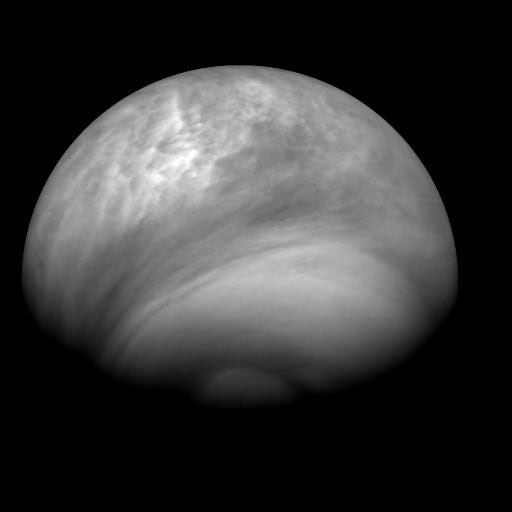IPSL Venus GCM
Model and main results
In the current version of the Venus GCM, based on the LMDZ5 dynamical core, we use a horizontal resolution of 96 longitudes by 96 latitudes (3.75x1.875 degrees), on 50 levels from surface to roughly 95 km altitude. The orbit of Venus is taken as circular, and we neglect the inclination of Venus' rotation axis. We take into account the topography. The model is described in Lebonnois et al. (2010, 2016). Latest results are in Garate-Lopez and Lebonnois (2018).
Variable Cp: The standard version of the LMDZ dynamical core uses a single value for the specific heat Cp, but Cp varies in the atmosphere of Venus from 738 J/kg/K at 100 km altitude to 1181 J/kg/K near the surface. This variation of Cp with temperature needs to be taken into account, in order to get realistic adiabatic lapse rates in the whole atmosphere. Using an analytical description of Cp(T), I have taken this into account in the dynamical core with a new expression of the potential temperature.
Radiative transfer: For the moment, we use tabulated solar fluxes from Haus et al. (2014). However in the infrared, we use Net Exchange Rates matrices (Eymet et al., 2009) which allow a consistent computation of the temperature field. This is different from previous GCMs of Venus' atmosphere, which were based on simplified forcing of the temperature structure, and it has a crucial impact on the meridional circulation.
Mean circulation: Superrotation is obtained at the cloud level, above roughly 40~km altitude, but below this altitude, the zonal wind does not increase to the observed values. This discrepancy is a major pending question, though our studies emphasize the role of different wave activities on the angular momentum redistribution, in particular near the cloud-base and in the deep atmosphere. The meridional circulation consists of equator-to-pole cells, with the dominant one located within the cloud layers. The modeled temperature structure is globally quite consistent with observations. A peculiar feature of the polar areas, the cold collar, is now obtained in the simulations. We showed the impact on the formation of this structure of the latitudinal variations of the clouds. This coupling between cloud structure, radiation field and circulation needs to be fully taken into account in future improvements of the GCM. A convective layer is found between the base of the clouds (around 47~km), heated from the deep atmosphere below and the middle of the clouds (55-60~km altitude), region that is able to cool directly to space; this is consistent with observation of the stability structure above 40~km.
Additional processes:
Difficulties
Our GCM simulations (as well as those of other teams) show that the superrotation of Venus atmosphere is the result of a subtil equilibrium. It involves balance in the exchanges of angular momentum between surface and atmosphere, and balance in the angular momentum transport between the mean meridional circulation and the planetary waves, thermal tides, and gravity waves. Modeling this balance is sensitive to the dynamical core details, to the boundary conditions and possibly also to initial conditions.
The sensitivity to the dynamical core is illustrated by the many differences obtained in the recent modeling of Venus circulation, but has been more formally demonstrated in a comparative study between Venus GCMs under identical physical forcings conducted in a working group at ISSI, Bern, Switzerland (see Lebonnois et al. 2013). These studies revealed that various dynamical core which would give very similar results in Earth or Mars conditions, can predict very different circulation patterns in Venus-like conditions. The wide dispersion of the modeled wind fields in these studies has to be related to the various dynamical core implementations, through angular momentum conservation and/or horizontal dissipation processes. Since the planetary waves play a crucial role in the angular momentum balance, their representation in the spatial and temporal discretization mechanisms of the dynamical cores may also be part of this sensitivity.
Since they control the exchanges of angular momentum between the atmosphere and the surface, the lower boundary conditions used in the model also have a strong influence on the resulting wind field. The planetary boundary layer (PBL) scheme has an impact on the surface friction, but also on the temperature structure of the deepest atmospheric layer, therefore affecting the circulation close to the surface. The presence of topography introduces the mountain torque in the surface-atmosphere exchanges. This torque results from different surface pressures on the eastern and western (for its component affecting the zonal wind) sides of topographical features. It is a major component of these angular momentum exchanges, as shown e.g. in Lebonnois et al. (2010).
The sensitivity to initial conditions with such models is also a problem. Kido and Wakata (2008) first obtained different strengths for the zonal wind field when starting from rest or from pre-existing superrotation. Similar results were obtained during the ISSI inter-comparison study (Lebonnois et al. 2013), and also in recent simulations with the LMD Venus GCM.
Future studies
Among the studies we want to conduct in the near future:
